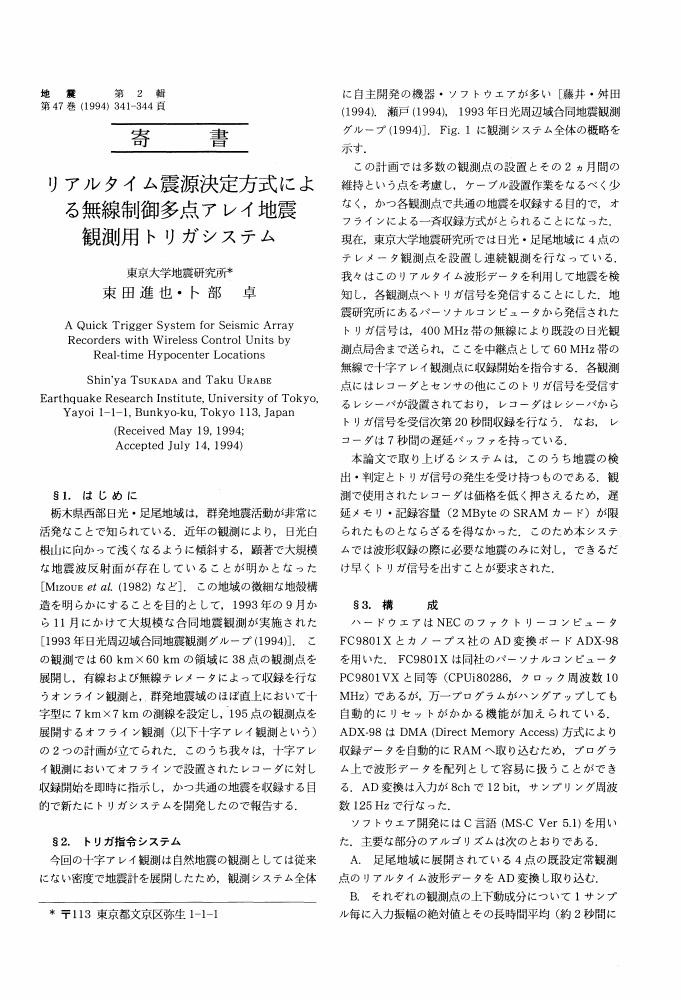1 0 0 0 OA リアルタイム震源決定方式による無線制御多点アレイ地震観測用トリガシステム
- 著者
- 束田 進也 卜部 卓
- 出版者
- 公益社団法人 日本地震学会
- 雑誌
- 地震 第2輯 (ISSN:00371114)
- 巻号頁・発行日
- vol.47, no.3, pp.341-344, 1994-10-14 (Released:2010-03-11)
- 参考文献数
- 4
1 0 0 0 OA 1988年爆破地震動観測による伊豆諸島・新島火山下の浅部地殻構造
- 著者
- 勝俣 啓 卜部 卓 森谷 正義 中村 正夫 瀬戸 憲彦 中村 功 溝上 恵
- 出版者
- 公益社団法人 日本地震学会
- 雑誌
- 地震 第2輯 (ISSN:00371114)
- 巻号頁・発行日
- vol.43, no.4, pp.499-511, 1990-12-24 (Released:2010-03-11)
- 参考文献数
- 4
Explosion seismic refraction experiments were carried out in 1988 for the investigation of the shallow crustal structure in the volcanic island of Nii-jima, northern part of Izu-Bonin island arc, Japan. One hundred and eight seismograms were obtained at 54 temporary stations aligned on the three profiles arranged like a triangle on the island. The main features of the shallow crustal velocity structure revealed by the travel time analysis are as follows:1) Surfaces of high velocity layers are raised beneath volcanos in the island of Nii-jima.2) The structure mostly consists of three layers with P-wave velocities of 1.9km/s, 2.8km/s and 4.5km/s, respectively.3) A layer with a velocity of 1.5km/s exists over the 1.9km/s layer at two explosion sites in shore.4) There is no 1.9km/s layer beneath Mt. Acchi volcano in the northern part of the island.5) The top of the 2.8km/s layer is much shallower beneath Mt. Mineji volcano in the central part of the island and beneath Ajiaiso beach in the northwestern part of the island.6) Both top of the 2.8km/s layer and that of the 4.5km/s layer are much shallower beneath Mt. Acchi volcano in the northern part of the island.7) The 1.9km/s layer is thicker beneath the small plain in the central part of the inland, beneath the place between Mt. Mineji and Ajiaiso beach, and beneath Wakago village in the northern part of the island.
1 0 0 0 OA 地震活動から見た三宅島2000年噴火時のマグマの移動
- 著者
- 酒井 慎一 山田 知朗 井出 哲 望月 将志 塩原 肇 卜部 卓 平田 直 篠原 雅尚 金沢 敏彦 西澤 あずさ 藤江 剛 三ヶ田 均
- 出版者
- 公益社団法人 東京地学協会
- 雑誌
- 地学雑誌 (ISSN:0022135X)
- 巻号頁・発行日
- vol.110, no.2, pp.145-155, 2001-04-25 (Released:2009-11-12)
- 参考文献数
- 6
- 被引用文献数
- 38 54
From June 26, 2000, an intensive earthquake swarm started under Miyake-jima Island, 180 km south off Japan. This swarm was closely related to the eruption of Miyake-jima Island, probably dominated by underground magmatic activity. The swarm spread toward the northwestern ocean region from Miyake-jima Island, in which a huge number of earthquakes (over 100, 000) including five large events of M>6.0 were detected over about two months. This earthquake swarm was the most active since we started seismic observations in the 1970's.Although there are some telemetered observation stations on the Izu volcanic islands, no offshore instruments were operated in the area of this earthquake swarm. To understand both the spatial and temporal changes of this activity, we conducted a series of ocean bottom seismometer observations. According to the variation in the seismic activity with time, we changed the array configuration of OBSs six times. Furthermore, real-time seismic observations were undertaken using a buoy-telemetering OBS system.Combining the OBS data with those of the island stations, very precise earthquake locations were determined. The epicenter distribution obtained strongly indicates a northwest-southeastern lineament. The vertical cross-section of the events shows two characteristic trends. Deeper (7- 13km) events are forming a very thin (2-km thick) plane, while shallower ones (< 7 km) show a much thicker distribution. These distribution patterns will provide important constraints on the physical mechanism for understaning magma migration.
